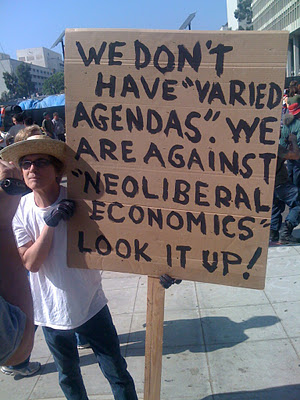The American satellite television network Free Speech TV asked me to write up a blurb for their monthly newsletter about my participatory/observatory trip with them to the National Conference on Media Reform in Boston. This is my attempt at what Henry Jenkins calls “critical pessimism”–an “exaggeration” that “frighten readers into taking action” to stop media consolidation, exclusion, and the absence of televisual diversity.
Free Speech TV at the National Conference on Media Reform
From its inception in 1995, Free Speech TV’s goal has been to infiltrate and subvert the vapid, shrill and corporately controlled American television newscape with challenging and unheard voices. Fast forward to 2011, and in the age of viral videos, social media and ubiquitous computing, the same issues persist.
An excellent young pro-freedom-of-speech organization, Free Press, called all media activists to Boston for the National Conference on Media Reform (NCMR), April 8-10, to celebrate independent media and incubate strategies to fight the tide of corporate personhood, monopolization in communication industries, and the denial of access to the public airwaves.
These are issues FSTV has long fought, first with VHS tapes of radical documentaries shipped to community access stations throughout the nation, then through satellite carriage in 30 million homes, and now via live internet video and direct dialogues with the audience through social media.
FSTV was at NCMR in full force, covering live panels on everything from the role of social media in North African revolutions to media’s sexualization of women; developing strategic relationships with print, radio, internet and television collaborators; interviewing luminaries like FCC Commissioner Copps; and inspiring the delegates by opening up the otherwise closed and corporatized satellite television world to the voices of media activists fighting for access and diversity during a frankly terrifying period in American media freedom.
One question haunted the many stages, daises and dialogues at the NCMR: Is the open, decentralized, accessible and diverse internet – by which media production, citizen journalism and community collaboration have been recently democratized – becoming closed, centralized and homogenous as it begins to look and feel more like the elite-controlled cable television system?
For example, while we were in the conference, the House voted to block the FCC from protecting our right to access an open Internet. The mergers of Comcast and NBC-Universal and AT&T/T-Mobile loomed behind every passionate oration. And yet FSTV was there to document when FCC Commissioner Copps took the stage stating he would resist the denial of network neutrality and such monopolizing mergers.
Internationally, examples of the power and problems of the internet exist. The Egypt-based Facebook group “We are all Khaled Said” had 80,000 members, many who amassed at Tahrir Square on January 26, instigating a wave of democratization that began in Tunisia – also fueled by social media – and hopefully continuing to Libya. Two days later, however, the Mubarak regime was able effectively to hit a “kill switch” on the internet and target activists using Facebook for arrest, an activity that worked against the desires of the repressive regime. At the NCMR, Democracy Now! reporter Sharif Abdel Kouddous said, “Facebook was down … so they hit the streets. It had the reverse desire and effect that the government wanted to happen.”
In 2010, Reporters Without Borders compiled a list of 13 internet enemies – countries that suppress free speech online. The U.S. wasn’t on the list, but U.S. companies Amazon, Paypal, Mastercard, Visa and Apple were pressured to cut digital and financial support for whistleblowing WikiLeaks. The point is obvious: A vigilant press aided by an open, uncensored and unprivatized internet are necessary yet threatened and are the focus of FSTV’s coverage at NCMR.
FSTV embodies that ancient movement of ordinary people taking back power from entrenched elites. Today, every issue, from class inequality to ecological justice – is a media issue. However, our media sources, from journalists to internet and television delivery systems, are being co-opted by monopolizing corporations and lobbyists. As an independent, open and interactive television network, FSTV is an antidote to the problems facing free speech and democracy as more media power is centralized in fewer hands. Thankfully, as we found out in Boston, FSTV is not alone in this dangerous and difficult operation of media liberation.
Jenkins hyperbolically describes “critical pessimists” as people who “opt out of media altogether and live in the woods, eating acorns and lizards and reading only books published on recycled paper by small alternative presses”. This is a false exaggeration of a movement that is providing a necessary check on corporate power and mindfully working for greater civic, community, and citizen involvement in media production.
 This Anthro Life – Savage Minds Crossover Series, part 2
This Anthro Life – Savage Minds Crossover Series, part 2
